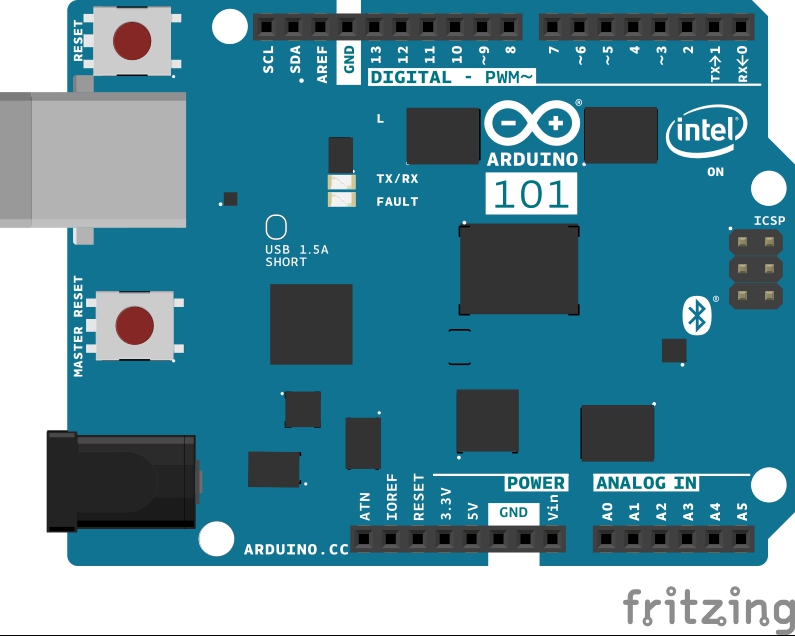Eğitimler
Genuino101CurieIMUTapDetect
Bu öğretici ile, sınırlı bir zaman aralığında ve üç eksenden herhangi birinde tahta üzerinde yapılan çift muslukları nasıl tespit edeceğinizi öğreneceksiniz. Bu eğitici, daha güçlü musluklar için ivmeölçer aralığını ayarlar ve iki musluğu çift dokunma olayı olarak değerlendirmek için çeyrek saniyelik bir pencere ayarlar.
Gerekli Donanım
Devre

Bu öğreticiyi kullanmak için ek donanıma gerek yoktur.
Yazılım Temelleri
Kütüphaneler
CurieIMU .h, 101 anakartın IMU yongasının tüm parametrelerine, özelliklerine ve okumalarına erişim sağlayan kütüphanedir. Bu ünite üç eksenli ivmeölçer ve üç eksenli jiroskop içerir. Bu kütüphane, 101 kart çekirdeğinin bir parçasıdır ve Arduino veya Genuino 101 için çekirdek dosyalarla birlikte yüklenir. Bu eğitimde, IMU'nun Tap algılama özelliğini bu kütüphanenin özel fonksiyonları aracılığıyla kullanıyoruz.
Fonksiyonlar
Yok
Kod
Bu çizim, çift dokunma algılama olayını ayarlamak için gerekli tüm kodu içeren kurulum bloğuna sahiptir. Kesme etkindir ve iddia edildiğinde geri arama fonksiyonu tarafından servis yapılır. Bu işlev, Seri bağlantı noktasına çift dokunmanın eksenini ve yönünü yazdırmak için tüm eksen ve yön kombinasyonlarını okur. Ana döngü boş.
* Copyright (c) 2016 Intel Corporation. All rights reserved.
* See the bottom of this file for the license terms.
*/
/*
This sketch example demonstrates how the BMI160 accelerometer on the
Intel(R) Curie(TM) module can be used to detect tap events
*/
#include "CurieIMU.h"
void setup() {
Serial.begin(9600); // initialize Serial communication
while(!Serial) ; // wait for serial port to connect.
// Initialise the IMU
CurieIMU.begin();
CurieIMU.attachInterrupt(eventCallback);
// Increase Accelerometer range to allow detection of stronger taps (< 4g)
CurieIMU.setAccelerometerRange(4);
// Reduce threshold to allow detection of weaker taps (>= 750mg)
CurieIMU.setDetectionThreshold(CURIE_IMU_TAP, 750); // (750mg)
// Enable Double-Tap detection
CurieIMU.interrupts(CURIE_IMU_TAP);
Serial.println("IMU initialization complete, waiting for events...");
}
void loop() {
// nothing happens in the loop because all the action happens
// in the callback function.
}
static void eventCallback()
{
if (CurieIMU.getInterruptStatus(CURIE_IMU_TAP)) {
if (CurieIMU.tapDetected(X_AXIS, NEGATIVE))
Serial.println("Tap detected on negative X-axis");
if (CurieIMU.tapDetected(X_AXIS, POSITIVE))
Serial.println("Tap detected on positive X-axis");
if (CurieIMU.tapDetected(Y_AXIS, NEGATIVE))
Serial.println("Tap detected on negative Y-axis");
if (CurieIMU.tapDetected(Y_AXIS, POSITIVE))
Serial.println("Tap detected on positive Y-axis");
if (CurieIMU.tapDetected(Z_AXIS, NEGATIVE))
Serial.println("Tap detected on negative Z-axis");
if (CurieIMU.tapDetected(Z_AXIS, POSITIVE))
Serial.println("Tap detected on positive Z-axis");
}
}
/*
Copyright (c) 2016 Intel Corporation. All rights reserved.
This library is free software; you can redistribute it and/or
modify it under the terms of the GNU Lesser General Public
License as published by the Free Software Foundation; either
version 2.1 of the License, or (at your option) any later version.
This library is distributed in the hope that it will be useful,
but WITHOUT ANY WARRANTY; without even the implied warranty of
MERCHANTABILITY or FITNESS FOR A PARTICULAR PURPOSE. See the GNU
Lesser General Public License for more details.
You should have received a copy of the GNU Lesser General Public
License along with this library; if not, write to the Free Software
Foundation, Inc., 51 Franklin Street, Fifth Floor, Boston, MA 02110-1301 USA
*/
